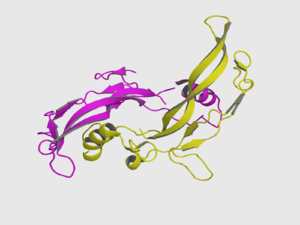- Inhibin A
-
Inhibin ist - im menschlichen Organismus - ein als Glykoprotein gebildetes Proteohormon, welches in den Sertolizellen der Hoden und in den Granulosazellen der Eierstöcke gebildet wird. Es reguliert die FSH-Freisetzung: Die Ausschüttung des Inhibins wird durch FSH stimuliert, gleichzeitig hemmt es dessen Freisetzung an der Hirnanhangdrüse (Hypophyse). Namensgebend war die Inhibition der FSH-Bildung in der Hirnanhangdrüse. Die Substanz "Inhibin" wurde bereits von McCullagh 1932 postuliert [1], die Isolierung und Charakterisierung gelang aber erst 1985 [2].
Inhibin besteht aus zwei Eiweißketten, einer Alpha- und eine Beta-Kette. Da es zwei verschiedene Beta-Ketten (Beta-A und Beta-B) gibt, können zwei verschiedene Inhibine gebildet werden: Inhibin A (aus einer Alpha- und einer Beta-A-Kette) sowie Inhibin B (aus einer Alpha- und einer Beta-B-Kette). Inhibin A kommt vorwiegend in Eierstöcken, Inhibin B in Hoden vor (siehe oben).
Als Besonderheit in der Gruppe der Eiweißhormone können sich auch zwei Beta-Ketten zusammenlagern und bilden dann ein Hormon namens Activin, welches im Gegensatz zum Inhibin das FSH nicht hemmt, sondern seine Freisetzung aus der Hirnanhangdrüse stimuliert. Je nach Kettenzusammensetzung gibt es folglich Activin A (zwei Beta-A-Ketten), Activin B (zwei Beta-B-Ketten) und Activin AB (Beta-A- und Beta-B-Kette). Die Erstbeschreibung erfolgte zeitgleich durch zwei Arbeitsgruppen, die in verschiedenen Stockwerken des Salk-Instituts in La Jolla/Kalifornien arbeiteten und ihre Entdeckung im gleichen Heft der Zeitschrift Nature publizierten [3] [4]. Die Arbeitsgruppe von N. Ling prägte im zitierten Artikel den Begriff "Activin" wegen der FSH-stimulierenden Wirkung.
Neben den bekannteren Activin-Untereinheiten (Beta-Ketten), Activin beta A und Activin beta B wurden in Säugetieren noch 2 weitere Unterheiten (Activin beta C und Activin beta E) beschrieben, welche sowohl Homo- als auch Heterodimere bilden können. Ihre physiologische Funktion ist noch weitgehend ungeklärt. Im Xenopus laevis wurde des Weiteren noch Activin beta D beschrieben. [5]
Daneben werden Hormone aus der Gruppe der Inhibine ebenso in anderen tierischen wie auch pflanzlichen Organismen gebildet. Wegen der hohen Konservierung zwischen den Spezies ist anzunehmen, dass Inhibin und Activin wichtige Hormone nicht nur für die Sexualfunktion sind. Sie spielen u. a. auch eine Rolle in der Zellteilung von Xenopus laevis.
Inhibin darf nicht mit den antimikrobiell wirksamen Inhibinen (u.A. im Honig) verwechselt werden.Quellen
- ↑ McCullagh DR. Dual endocrine activity of the testes. Science 1932; 76:19-20. PMID 17815236
- ↑ Ling N, Ying SY, Ueno N et al. Isolation and partial characterization of a Mr 32,000 protein with inhibin activity from porcine follicular fluid Proc Natl Acad Sci. 1985;82:7217-7221. PMID 3864157
- ↑ Vale W, Rivier J, Vaughan J et al. Purification and characterization of an FSH releasing protein from procine ovarian follicular fluid Nature. 1986;321:776-779. PMID 3012369
- ↑ Ling N, Ying SY, Ueno N et al. Pituitary FSH is released by a heterodimer of the beta-subunits from the two forms of inhibin Nature. 1986;321:779-782. PMID 3086749
- ↑ Deli A, Kreidl E et al. Activins and activin antagonists in hepatocellular carcinoma. World J Gastroenterol. 2008 Mar 21;14(11):1699-709. PMID 18350601
Wikimedia Foundation.

